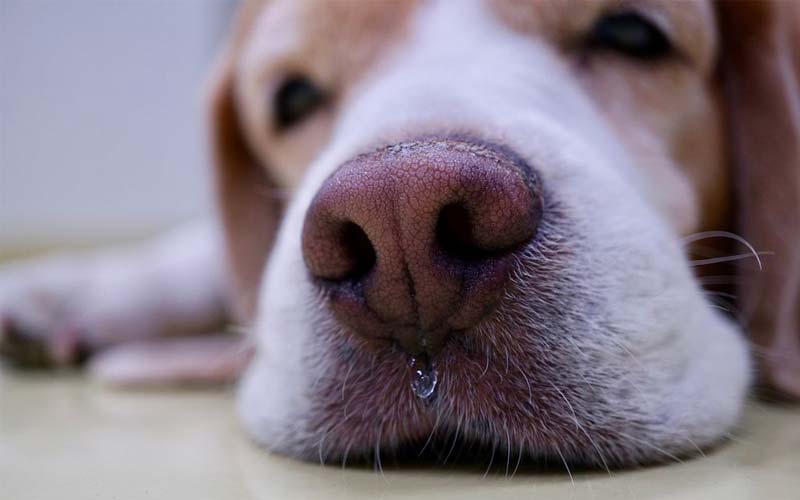Seeing your dog struggle to breathe due to congestion can be a distressing experience for any pet owner. Much like in humans, nasal congestion in dogs can stem from various causes, including allergies, respiratory infections, or exposure to irritants. When your dog’s nasal passages become blocked or inflamed, it can lead to discomfort, reduced energy, and even difficulty sleeping or eating.

Fortunately, there are several home remedies that can effectively alleviate your dog’s congestion and help them breathe more comfortably. These remedies are not only easy to implement but also safe, making them an excellent first step in addressing your pet’s symptoms before seeking veterinary care. In this article, we’ll explore some of the most effective strategies for relieving dog congestion at home, from steam therapy to the use of humidifiers, saline drops, and more.
By the end of this guide, you’ll be equipped with the knowledge to help your dog feel better and breathe easier, providing them with the relief they need and the comfort they deserve.
I. Understanding Dog Congestion
What is Dog Congestion?
Dog congestion refers to the accumulation of mucus or fluids in a dog’s nasal passages, which can lead to difficulty breathing, a blocked nose, and other respiratory discomforts. It’s similar to what humans experience when they have a cold or allergies. When a dog is congested, it might display signs of nasal blockage, such as sniffing more than usual, or it may have labored breathing due to the restricted airflow. This congestion can be uncomfortable and, if left untreated, can lead to further health complications.
Common Symptoms to Watch For
Recognizing the symptoms of congestion in your dog is crucial for early intervention. Here are the most common signs to look out for:
- Nasal Discharge: Clear, white, or yellowish mucus coming from the nose. This is often the first noticeable sign of congestion.
- Sneezing: Frequent or repetitive sneezing is a common symptom, especially when the nasal passages are irritated.
- Coughing: Coughing occurs when mucus drips down the throat, irritating it and causing your dog to cough in an attempt to clear it.
- Labored Breathing: Noisy or heavy breathing, which can sometimes include wheezing, indicates that your dog is struggling to get enough air.
- Lethargy: Your dog may appear more tired than usual, preferring to rest rather than play, due to the discomfort caused by congestion.
Potential Causes of Congestion
There are several potential causes for congestion in dogs, ranging from mild to more serious conditions:
- Allergies: Environmental allergens like pollen, dust, or mold can irritate a dog’s respiratory system, leading to congestion.
- Infections: Respiratory infections such as kennel cough, canine influenza, or bacterial infections can cause inflammation and mucus production in the nasal passages.
- Foreign Objects: Small objects or debris lodged in the nasal passages can block airflow, causing congestion and discomfort.
- Cold Weather: Exposure to cold or dry air can dry out the nasal passages, making them more susceptible to congestion.
- Dental Issues: Infections or abscesses in the mouth, particularly in the upper jaw, can sometimes lead to sinus infections and congestion.

II. Home Remedies for Dog Congestion
1. Steam Therapy
Description: Steam therapy can be a simple yet effective way to help loosen mucus in your dog’s nasal passages, making it easier for them to breathe.
Instructions:
- Step 1: Run a hot shower in your bathroom to create steam, ensuring the door is closed to keep the steam contained.
- Step 2: Once the room is filled with steam, bring your dog into the bathroom and sit with them for about 10-15 minutes. Ensure your dog is comfortable and not too hot.
- Step 3: Stay with your dog the entire time to monitor their comfort level, and avoid letting them get too close to the hot water to prevent burns.
- Step 4: After the steam session, gently wipe away any loosened mucus from your dog’s nose.
2. Humidifier Use
Description: A humidifier adds moisture to the air, which can prevent your dog’s nasal passages from becoming dry and irritated, thus helping to relieve congestion.
Instructions:
- Step 1: Choose a humidifier that is safe and quiet enough to run throughout the night or during the day when your dog is resting.
- Step 2: Place the humidifier in the room where your dog spends most of their time, ideally near their bed.
- Step 3: Ensure the humidifier is kept clean and filled with fresh water daily to prevent mold or bacteria buildup.
- Step 4: Monitor the room’s humidity level to keep it within a comfortable range, typically between 40% and 60%.
3. Saline Nasal Drops
Description: Saline drops can help clear a dog’s nasal passages by loosening thick mucus and reducing inflammation.
Instructions:
- Step 1: Purchase a pet-safe saline solution from your vet or local pet store.
- Step 2: Gently restrain your dog, keeping them calm and still.
- Step 3: Tilt your dog’s head slightly back and carefully apply a few drops of the saline solution into each nostril.
- Step 4: Allow your dog to shake their head afterward to clear out the mucus. Wipe away any excess with a soft cloth.
- Step 5: Always consult your vet before using saline drops, especially if your dog has ongoing nasal issues.
4. Elevate Your Dog’s Head
Description: Elevating your dog’s head while they rest can reduce nasal drip and make breathing easier by preventing mucus from pooling in the nasal passages.
Instructions:
- Step 1: Use a pillow, folded towel, or a specially designed dog bed to elevate your dog’s head while they sleep.
- Step 2: Ensure the elevation is slight and comfortable, as too much elevation can strain your dog’s neck.
- Step 3: Monitor your dog to ensure they remain comfortable and adjust the elevation as needed.
5. Honey and Warm Water
Description: Honey is a natural remedy with antibacterial properties that can soothe a dog’s throat, especially if they are coughing due to post-nasal drip.
Instructions:
- Step 1: Mix one teaspoon of honey with a small amount of warm water.
- Step 2: Offer this mixture to your dog up to twice daily, depending on their size (consult your vet for precise dosing).
- Step 3: Ensure the honey you use is raw and unprocessed, as processed honey loses many of its beneficial properties.

6. Ensure Adequate Hydration
Description: Keeping your dog well-hydrated helps to thin mucus, making it easier for them to expel it and breathe more comfortably.
Instructions:
- Step 1: Encourage your dog to drink plenty of water throughout the day.
- Step 2: If your dog is reluctant to drink water, try offering them low-sodium chicken broth as an alternative.
- Step 3: You can also add a small amount of water to their food to increase their overall fluid intake.
7. Chicken Broth
Description: Warm, low-sodium chicken broth can soothe an irritated throat and encourage a congested dog to stay hydrated.
Instructions:
- Step 1: Warm up some low-sodium chicken broth until it’s slightly warmer than room temperature but not hot.
- Step 2: Offer the broth to your dog in a bowl, allowing them to drink at their own pace.
- Step 3: Ensure the broth is free from onions, garlic, and other ingredients that are toxic to dogs.
- Step 4: You can give this to your dog once or twice a day as part of their regular fluid intake.
Conclusion
In conclusion, helping your congested dog breathe better involves understanding the symptoms and causes of congestion and applying effective home remedies to provide relief. By recognizing signs like nasal discharge, coughing, and labored breathing early on, you can take proactive steps to ease your dog’s discomfort. Remedies such as steam therapy, using a humidifier, administering saline nasal drops, and ensuring adequate hydration are all practical, safe methods to manage mild congestion at home.
However, it’s important to remember that while these home remedies can be highly effective, they are not a substitute for professional veterinary care. If your dog’s symptoms persist or worsen, seeking veterinary advice is crucial to rule out more serious conditions.
I encourage you to try these remedies if your dog shows signs of congestion, but always keep a close eye on their condition. Your prompt attention and care can make a significant difference in your dog’s comfort and well-being. And don’t hesitate to consult your veterinarian if you’re unsure about the best course of action for your pet. By staying informed and vigilant, you can help your dog breathe easier and live a happier, healthier life.